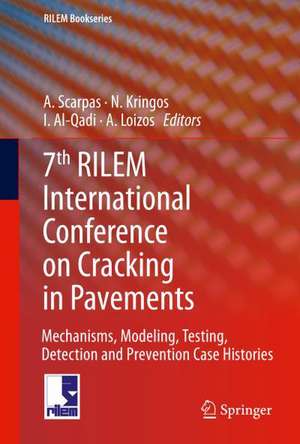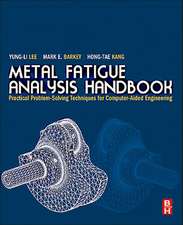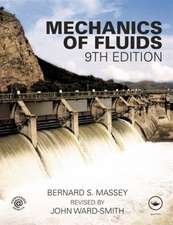7th RILEM International Conference on Cracking in Pavements: Mechanisms, Modeling, Testing, Detection and Prevention Case Histories: RILEM Bookseries, cartea 4
Editat de A. Scarpas, Niki Kringos, I. Al-Qadi, Loizos A.en Limba Engleză Hardback – 9 iun 2012
All submitted contributions were subjected to an exhaustive refereed peer review procedure by the Scientific Committee, the Editors and a large group of international experts in the topic. On the basis of their recommendations, 129 contributions which best suited the goals and the objectives of the Conference were chosen for presentation and inclusion in the Proceedings.
The strong message that emanates from the accepted contributions is that, by accounting for the idiosyncrasies of the response of pavement engineering materials, modern sophisticated constitutive models in combination with new experimental material characterization and construction techniques provide a powerful arsenal for understanding and designing against the mechanisms and the processes causing cracking and pavement response deterioration. As such they enable the adoption of truly "mechanistic" design methodologies.
The papers represent the following topics: Laboratory evaluation of asphalt concrete cracking potential; Pavement cracking detection; Field investigation of pavement cracking; Pavement cracking modeling response, crack analysis and damage prediction; Performance of concrete pavements and white toppings; Fatigue cracking and damage characterization of asphalt concrete; Evaluation of the effectiveness of asphalt concretemodification; Crack growth parameters and mechanisms; Evaluation, quantification and modeling of asphalt healing properties; Reinforcement and interlayer systems for crack mitigation; Thermal and low temperature cracking of pavements; and Cracking propensity of WMA and recycled asphalts.
| Toate formatele și edițiile | Preț | Express |
|---|---|---|
| Paperback (1) | 1627.92 lei 38-44 zile | |
| SPRINGER NETHERLANDS – 23 aug 2016 | 1627.92 lei 38-44 zile | |
| Hardback (1) | 1646.95 lei 38-44 zile | |
| SPRINGER NETHERLANDS – 9 iun 2012 | 1646.95 lei 38-44 zile |
Din seria RILEM Bookseries
- 18%
 Preț: 952.09 lei
Preț: 952.09 lei - 24%
 Preț: 1946.92 lei
Preț: 1946.92 lei - 18%
 Preț: 1872.30 lei
Preț: 1872.30 lei - 18%
 Preț: 1401.16 lei
Preț: 1401.16 lei - 18%
 Preț: 2154.04 lei
Preț: 2154.04 lei - 18%
 Preț: 1824.32 lei
Preț: 1824.32 lei - 18%
 Preț: 1401.61 lei
Preț: 1401.61 lei - 24%
 Preț: 1125.13 lei
Preț: 1125.13 lei - 20%
 Preț: 573.07 lei
Preț: 573.07 lei - 18%
 Preț: 1246.95 lei
Preț: 1246.95 lei - 24%
 Preț: 797.66 lei
Preț: 797.66 lei - 18%
 Preț: 1247.88 lei
Preț: 1247.88 lei - 18%
 Preț: 1561.68 lei
Preț: 1561.68 lei - 24%
 Preț: 788.48 lei
Preț: 788.48 lei - 24%
 Preț: 3265.87 lei
Preț: 3265.87 lei - 18%
 Preț: 1234.62 lei
Preț: 1234.62 lei - 18%
 Preț: 952.89 lei
Preț: 952.89 lei - 18%
 Preț: 939.46 lei
Preț: 939.46 lei - 18%
 Preț: 953.20 lei
Preț: 953.20 lei - 18%
 Preț: 1235.57 lei
Preț: 1235.57 lei - 18%
 Preț: 943.88 lei
Preț: 943.88 lei - 18%
 Preț: 1244.89 lei
Preț: 1244.89 lei - 18%
 Preț: 939.94 lei
Preț: 939.94 lei - 18%
 Preț: 1231.78 lei
Preț: 1231.78 lei - 18%
 Preț: 938.66 lei
Preț: 938.66 lei - 18%
 Preț: 2511.88 lei
Preț: 2511.88 lei - 18%
 Preț: 1222.94 lei
Preț: 1222.94 lei - 18%
 Preț: 947.85 lei
Preț: 947.85 lei - 18%
 Preț: 956.72 lei
Preț: 956.72 lei
Preț: 1646.95 lei
Preț vechi: 2167.03 lei
-24% Nou
Puncte Express: 2470
Preț estimativ în valută:
315.15€ • 329.87$ • 262.30£
315.15€ • 329.87$ • 262.30£
Carte tipărită la comandă
Livrare economică 27 martie-02 aprilie
Preluare comenzi: 021 569.72.76
Specificații
ISBN-13: 9789400745650
ISBN-10: 9400745656
Pagini: 1416
Ilustrații: XVIII, 1378 p. In 2 volumes, not available separately.
Dimensiuni: 155 x 235 x 80 mm
Greutate: 2.22 kg
Ediția:2012
Editura: SPRINGER NETHERLANDS
Colecția Springer
Seria RILEM Bookseries
Locul publicării:Dordrecht, Netherlands
ISBN-10: 9400745656
Pagini: 1416
Ilustrații: XVIII, 1378 p. In 2 volumes, not available separately.
Dimensiuni: 155 x 235 x 80 mm
Greutate: 2.22 kg
Ediția:2012
Editura: SPRINGER NETHERLANDS
Colecția Springer
Seria RILEM Bookseries
Locul publicării:Dordrecht, Netherlands
Public țintă
ResearchCuprins
Laboratory evaluation of asphalt concrete cracking potential: Characterization of Asphalt Mixture’s Fracture Resistance Using the Semi-Circular Bending (SCB) Test.- Determining the Flexural Strength of Asphalt Mixtures Using the Bending Beam Rheometer.- Experimental study of the precracking.- Comparison between 2PB and 4PB methodologies based on the dissipated energy approach .- Evaluation of thermal stresses in asphalt layers incomparison with TSRST test results.- A four-point bending test for the bonding evaluation of composite pavement.- Assessment of cracking resistance of bituminous mixtures by means of Fenix test.- Development of Dynamic Asphalt Stripping Machine for Better Prediction of Moisture Damage on Porous Asphalt in the Field.- Effect of Wheel Track Sample Geometry on Results.- Performance of ‘SAMI’S in simulative testing.- Towards a New Experimental and Numerical Protocol for Determining Mastic Viscosity.- Interference Factors on Tests of Asphalt Biding Agents Destinated to Paving Works Using a Statistic Study.- Pavement cracking detection: The Use of Ground Penetrating Radar, Thermal Camera and Laser Scanner Technology in Asphalt Crack Detection and Diagnostics.- Asphalt Thermal Cracking Analyser (ATCA).- Using 3D laser profiling sensors for the automated measurement of road surface conditions.- Pavement Crack Detection Using High-resolution 3D Line Laser Imaging Technology.- Detecting unbounded interface with non destructive techniques.- New Field Testing Procedure to Measure Surface Stresses in Plain Concrete Pavements and Structures.- Strain Measurement in Pavements with a Fibre Optics Sensor Enabled Geotextile.- Field investigation of pavement cracking: Evaluating the low temperature resistance of the asphalt pavement under the climatic conditions of Kazakhstan.- Millau viaduct response under static and moving loads considering viscous bituminous wearing course materials.- Material PropertyTesting of Asphalt Binders Related to Thermal Cracking in a Comparative Site Pavement Performance Study.- Influence of Differential Displacements of Airport Pavements on Aircraft Fuelling Systems.- Rehabilitation of cracking in epoxy asphalt pavement on steel bridge decks.- Long-term pavement performance evaluation.- Structural Assessment of Cracked Flexible Pavement.- Comparison Between Optimum Tack Coat Application Rates as Obtained from Shear- and Tension-type Tests.- Using Life Cycle Assessment to Optimize Pavement Crack-Mitigation.- Preliminary Analysis of Quality-Related Specification Approach for Cracking on Low Volume Hot Mix Asphalt Roads.- Evaluating root resistance of asphaltic pavement focusing on woody plants’ root growth.- 20 Years of Research on Asphalt Reinforcement – Achievements and Future Needs.- Concrete Pavement Strength Investigations at the FAA National Airport Pavement Test Facility.- Pavement cracking modeling response, crack analysis and damage prediction: The Effects Non-Uniform Contact Pressure Distribution has on Surface Distress of Flexible Pavements using a Finite Element Method.- Finite Element Analysis of a New Test Specimen for Investigating Mixed Mode Cracks in Asphalt Overlays .- Modelling of the Initiation and Development of Transverse Cracks in Jointed Plain Concrete Pavements for Dutch Conditions.- Pavement Response Excited by Road Unevennesses using the Boundary Element Method.- Discrete particle element analysis of aggregate interaction in granular mixes for asphalt: combined DEM and experimental study.- Recent Developments and Applications of Pavement Analysis Using Nonlinear Damage (PANDA) Model.- Laboratory and Computational Evaluation of Compact Tension Fracture Test and Texas Overlay Tester for Asphalt Concrete.- Crack Fundamental Element (CFE) for Multi-scale Crack Classification .- Cracking Models for Use in Pavement Maintenance Management.- Multi-cracks modeling inreflective cracking.- Using Black Space Diagrams to Predict Age-Induced Cracking.- Top-Down Cracking Prediction Tool for Hot Mix Asphalt Pavements.- A theoretical investigation into the 4 point bending Test.- Multiscale Micromechanical Lattice Modeling of Cracking in Asphalt Concrete.- Accelerated Pavement Performance Modeling Using Layered Viscoelastic Analysis.- Numerical investigations on the deformation behavior of concrete pavements.- Fatigue behavior modelling in the Mechanistic Empirical Pavement Design.- Theoretical Analysis of Overlay Resisting Crack Propagation in Old Cement Concrete Pavement.- Calibration of Asphalt Concrete Cracking Models for California Mechanistic-Empirical Design (CalME).- Performance of concrete pavements and white toppings: Shear Failure in Plain Concrete as Applied to Concrete Pavement Overlays.- Influence of Residual Stress on PCC Pavement Potential Cracking.- Plain Concrete Cyclic Crack Resistance Curves under Constant and Variable Amplitude Loading.- Influence of external alkali supply on cracking in concrete pavements.- Plastic Shrinkage Cracking Risk of Concrete - Evaluation of Test Methods.- Compatibility between base concrete made with different chemical admixtures and surface hardener.- Compatibility between a quartz surface hardener and different base concrete mixtures.- Suitable Restrained Shrinkage Test for Fibre Reinforced Concrete: a critical discussion.- Influence of Chemical Admixtures and Environmental Conditions on Initial Hydration of Concrete.- Application of different fibers to reduce plastic shrinkage cracking of concrete.- Fatigue cracking and damage characterization of asphalt concrete: Evaluation of Fatigue Life Using Dissipated Energy Methods.- Measurement and prediction model of the fatigue behavior of glass fiber reinforced bituminous mixture.- Fatigue Cracking in Bituminous Mixture using Four Point Bending Test.- Top-down and Bottom-up Fatigue Cracking ofBituminous Pavements Subjected to Tangential Moving Loads.- Fatigue Performance of Highly Modified Asphalt Mixtures in Laboratory and Field Environment.- A multi-linear fatigue life model of flexible pavements under multiple axle loadings.- Aggregate Base/Granular Subbase Quality Affecting Fatigue Cracking of Conventional Flexible Pavements in Minnesota.- Fatigue Performance of Asphalt Concretes with RAP aggregates and Steel Slags.- Fatigue Characterization of Asphalt Rubber Mixtures with Steel Slags.- Fatigue Cracking of Gravel Asphalt Concrete.- Cumulative Damage Determination.- Fatigue Resistance and Crack Propagation Evaluation of a Rubber-Modified Gap Graded Mixture in Sweden.- On the Fatigue Criterion for Calculating the Thickness of Asphalt Layers.- Acoustic Techniques for Fatigue Cracking Mechanisms Characterization in Hot Mix Asphalt (HMA) .- Fatigue characteristics of sulphur modified asphalt mixtures.- Effect of Moisture Conditioning on Fatigue Properties of Sulphur Modified Asphalt Mixtures.- Fatigue investigation of mastics and bitumens using Annular Shear Rheometer prototype equipped with wave propagation system.- Effect of Steel Fibre Content on the Fatigue Behaviour of Steel Fibre Reinforced Concrete.- Effect of Specimen Size on Fatigue Behavior of Asphalt Mixture in Laboratory Fatigue tests .- Evaluation of the effectiveness of asphalt concrete modification.- Long-Life Overlays By Use Of Highly Modified Bituminous Mixtures.- Investigation into Tensile properties of Polymer Modified Bitumen (PMB) and Mixture Performance .- Effect of Polymer Dispersion on the Rheology and Morphology of Polymer Modified Bituminous Blend.- Effect of Organoclay Modified Binders on Fatigue Performance.- Effects of Polymer Modified Asphalt Emulsion (PMAE) on Pavement Reflective Cracking Performance .- Characterization of long term field aging of polymer modified bitumen in porous asphalt.- Bending Beam Rheological Evaluationof Wax Modified Asphalt Binders.- Reducing Asphalt’s Low Temperature Cracking by Disturbing its Crystallization.- MechanisticEvaluationof Lime-ModifiedAsphaltConcreteMixtures.- Crack growth parameters & mechanisms: Determination of crack growth parameters of asphalt mixtures.- Differential Thermal Contraction of Asphalt Components.- Mechanistic Pavement Design Considering Bottom-Up And Top-Down-Cracking.- Strength and Fracture Properties of Aggregates.- Cracks Characteristics and Damage Mechanism of Asphalt Pavement with Semi-rigid Base.- Comparing the Slope of Load/Displacement Fracture Curves of Asphalt Concrete.- Cracking Behaviour of Bitumen Stabilised Materials (BSMs): Is there such a thing?.- Experimental and theoretical investigation of three dimensional strain occurring near the surface in asphalt concrete layers.- Reasons of Premature Cracking Pavement Deterioration – A Case Study.- Effect of thickness of a sandwiched layer of bitumen between two aggregates on the bond strength: an experimental study.- Hypothesis of existence semicircular shaped cracks on asphalt pavements.- Quantifying the relationship between mechanisms of failure and the deterioration of CRCP under APT: cointegration of non-stationary time series.- Influence of Horizontal Traction on Top-Down Cracking in Asphalt Pavements.- Evaluation, quantification and modeling of asphalt healing properties: Predictingthe PerformanceoftheInduction Healing Porous Asphalt Test Section.- Determining the healing potential of asphalt concrete mixtures - A pragmatic approach.- Asphalt durability and self-healing modelling with discrete particles approach.- Quantifying healing based on viscoelastic continuum damage theory in fine aggregate asphalt specimen.- Evaluation of WMA Healing Properties Using Atomic Force Microscopy.- Cracking and Healing Modelling of Asphalt Mixtures.- Reinforcement & interlayer systems for crack mitigation: Effects of GlassFiber/Grid Reinforcement on the Crack Growth Rate of an Asphalt Mix.- Asphalt Rubber Interlayer Benefits in Minimizing Reflective Cracking of Overlays over Rigid Pavements.- Performance of anti-cracking interface systems on overlaid cement concrete slabs – development of laboratory test to simulate slab rocking.- The use of bituminous membranes and geosynthetics in the pavement construction.- Stress Relief Asphalt Layer and Reinforcing Polyester Grid as Anti-Reflective Cracking Composite Interlayer System in Pavement Rehabilitation.- Characterizing the effects of geosynthetics in asphalt pavements.- Geogrid Interlayer Performance in Pavements : Tensile-Bending Test for Crack Propagation .- Theoretical and computational analysis of airport flexible pavements reinforced with geogrids.- Optimization of Geocomposites for Double-Layered Bituminous Systems.- Sand Mix Interlayer Retarding Reflective Cracking in Asphalt Concrete Overlay.- Full scale tests on grid reinforced flexible pavements on the French fatigue carrousel.- Thermal and low temperature cracking of pavements: Low-temperature cracking of recycled asphalt mixtures.- Thermal Cracking Potential in Asphalt Mixtures with High RAP Contents.- Micro-Mechanical Investigation of Low Temperature Fatigue Cracking Behaviour of Bitumen.- The Study on Evaluation Methods of Asphalt Mixture Low Temperature Performance.- Cracking propensity of WMA & recycled asphalts: Permanent Deformations of WMAs related to the Bituminous Binder Temperature Susceptibility .- Cracking resistance of recycled asphalt mixtures in relation to blending of RA and virgin binder.- Warm Mix Asphalt Performance Modeling Using the Mechanistic-Empirical Pavement Design Guide.- Shrinkage and Creep Performance of Recycled Aggregate Concrete.- Effect of Reheating Plant Warm SMA on Its Fracture Potential.- Fatigue Cracking Characteristics of Cold In-Place Recycled Pavements.
Textul de pe ultima copertă
In the recent past, new materials, laboratory and in-situ testing methods and construction techniques have been introduced. In addition, modern computational techniques such as the finite element method enable the utilization of sophisticated constitutive models for realistic model-based predictions of the response of pavements. The 7th RILEM International Conference on Cracking of Pavements provided an international forum for the exchange of ideas, information and knowledge amongst experts involved in computational analysis, material production, experimental characterization, design and construction of pavements.
All submitted contributions were subjected to an exhaustive refereed peer review procedure by the Scientific Committee, the Editors and a large group of international experts in the topic. On the basis of their recommendations, 129 contributions which best suited the goals and the objectives of the Conference were chosen for presentation and inclusion in the Proceedings.
The strong message that emanates from the accepted contributions is that, by accounting for the idiosyncrasies of the response of pavement engineering materials, modern sophisticated constitutive models in combination with new experimental material characterization and construction techniques provide a powerful arsenal for understanding and designing against the mechanisms and the processes causing cracking and pavement response deterioration. As such they enable the adoption of truly "mechanistic" design methodologies.
The papers represent the following topics: Laboratory evaluation of asphalt concrete cracking potential; Pavement cracking detection; Field investigation of pavement cracking; Pavement cracking modeling response, crack analysis and damage prediction; Performance of concrete pavements and white toppings; Fatigue cracking and damage characterization of asphalt concrete; Evaluation of the effectiveness of asphalt concretemodification; Crack growth parameters and mechanisms; Evaluation, quantification and modeling of asphalt healing properties; Reinforcement and interlayer systems for crack mitigation; Thermal and low temperature cracking of pavements; and Cracking propensity of WMA and recycled asphalts.
All submitted contributions were subjected to an exhaustive refereed peer review procedure by the Scientific Committee, the Editors and a large group of international experts in the topic. On the basis of their recommendations, 129 contributions which best suited the goals and the objectives of the Conference were chosen for presentation and inclusion in the Proceedings.
The strong message that emanates from the accepted contributions is that, by accounting for the idiosyncrasies of the response of pavement engineering materials, modern sophisticated constitutive models in combination with new experimental material characterization and construction techniques provide a powerful arsenal for understanding and designing against the mechanisms and the processes causing cracking and pavement response deterioration. As such they enable the adoption of truly "mechanistic" design methodologies.
The papers represent the following topics: Laboratory evaluation of asphalt concrete cracking potential; Pavement cracking detection; Field investigation of pavement cracking; Pavement cracking modeling response, crack analysis and damage prediction; Performance of concrete pavements and white toppings; Fatigue cracking and damage characterization of asphalt concrete; Evaluation of the effectiveness of asphalt concretemodification; Crack growth parameters and mechanisms; Evaluation, quantification and modeling of asphalt healing properties; Reinforcement and interlayer systems for crack mitigation; Thermal and low temperature cracking of pavements; and Cracking propensity of WMA and recycled asphalts.
Caracteristici
State of the art research Sets the standard for the next few years Associated with prestigious society










